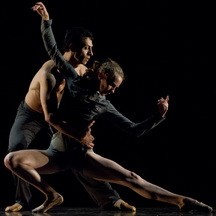True confession: I love Jerome Robbins’ choreography. As much as I admire and respect Balanchine’s choreography and his establishment of one of the most prominent and innovative ballet companies in the world, I love Robbins more. So it was with anticipation that I attended San Francisco Ballet’s Program 5: Robbins: Ballet and Broadway.
Robbins’ choreography is ideal for SF Ballet: it combines the purity of neoclassical ballet with warmth, inventiveness and wit. All this was most present in the evening’s Other Dances, danced by Frances Chung and Angelo Greco.
Other Dances was a spin-off, of sorts, from Robbins’ Dances at a Gathering. A ground-breaking work choreographed for NYCB in 1969, the hour-long Dances at a Gathering was set to Chopin, and presented a series of solos, duets, and pas de however-many that could be loosely interpreted as short love stories, so rich was the emotive content suggested by the steps.

Other Dances, choreographed in 1976, is a series of solos and duets also set to Chopin, and structured in the tradition of classical ballet with a duet, followed by two solos – alternating man and woman, and a final duet. Robbins expands this structure by adding another set of solos. And why not? Other Dances was originally choreographed for Mikhail Baryshnikov and Natalia Makarova.
One of the piece’s most striking features is its use of classical ballet’s character steps, a stylized interpretation of folk dance, in this case Eastern European folk dance. Most often this form is robust and energetic, despite its gentrification. And that is where the transformation occurs in Other Dances, and Robbins’ inventiveness overrides the expected. Folded into a tender and sustained classical ballet duet are character steps: a flick back of hand and head, a leg crossed over, the flexed foot extended on the ground, a skip, heel clicks. All of it slow and gently lingering, lyrical and sensual, creating an air of considered poignancy.
Chung and Greco danced this superbly. Both dancers have solidity in their style, which infused their interpretation not so much with delicacy as with vibrancy. And they were virtuosic without being self-conscious, which is key to dancing Robbins.
The evening opened with Opus 19/ The Dreamer, which premiered in 1979 and is reminiscent of Other Dances in its use of a classical/ neoclassical vocabulary with movements from modern dance blended seamlessly into an overall lyric tone. The piece is set to Prokofiev’s Violin Concerto No. 1 in D Major, and like Other Dances, a solitary instrument drives the choreography. The ballet’s wonderful symphony provided the excellent soloists, concertmaster Cordula Merks and pianist Natal’ya Feygina.
Carlo Di Lanno danced the Dreamer with Sarah Van Patten as both muse and nemesis; a corps of men and women react and interact. There is much of Balanchine in this piece, especially in the corps’ choreography. But the essential core of the piece, which steps in and out of narrative, is Robbins, and suggests an abiding discomfort in facing the world, a complex angst that is laced with longing. Di Lanno seems ideal for these romantic imaginings with his long, clean lines, assured partnering and contemplative style. All well suited to Van Patten. The two end the piece entangled in a pose evocative of a mural of Egyptian gods.
Separating these two neoclassical pieces was The Cage, the ballet that more or less made Robbins’ name as a ballet choreographer in 1951. It’s as angular as Robbins gets, and set to Stravinsky’s Concerto in D for String Orchestra. The Novice, danced by Maria Kochetkova, is born into a hive of half-woman half-insect beings, where the Queen (Sofiane Sylve) directs her in the practice of killing intruders. Male intruders, by the way. Robbins claimed there was no underlying gender issues going on in piece. I’ve never believed him. It’s a great piece though. Urgent and fiery in its energy, as the hive swoops down on its victims. Steven Morse, as the Second Intruder, danced the charged and insistent duet with Kochetkova, whose petite size gave the Novice a child-like quality in body, if not mind and intention.
The evening closed with Fancy Free, Robbins homage to male sexual energy. Set to Bernstein’s jazzy and witty music, the ballet is about three sailors on leave in New York City. And of course, they are looking for girls. Esteban Hernandez, Benjamin Freemantle and Lonnie Weeks danced the three sailors, with Weeks in the role that Robbins danced in the 1951 premiere. Sasha De Sola and Dores André admirably danced the two girls, whose favors the men compete for. This was a rambunctious, lively version, but it seemed a bit under-rehearsed, missing the precision of casualness that was so characteristic of the choreographer. Even so …
What the program lacked, sadly and almost glaringly, was something from West Side Story. Would that have been too obvious a choice?
Maybe next year …
–Jaime Robles
SF Ballet’s Program 6, with the National Ballet of Canada in John Neumeier’s Nijinsky, opens at the War Memorial on April 3. For information and tickets, visit sfballet.com.
